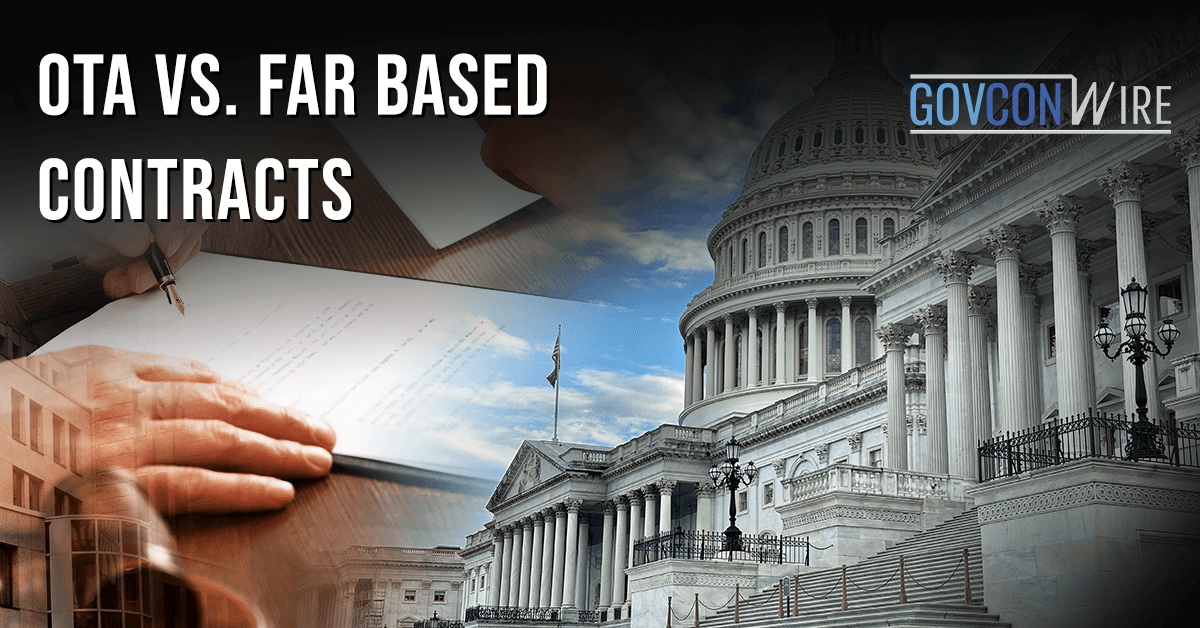In the world of government contracting, small business owners and government contractors face a crucial decision when it comes to choosing the right contract type. Understanding the differences between Other Transaction Authority (OTA) contracts and Federal Acquisition Regulation (FAR) based contracts is essential for making informed decisions that can impact your business’s success. This guide will demystify these two contract types, providing valuable insights for those looking to optimize their government contracting strategy.
Understanding FAR Contracts
What Is a FAR Based Contract?
FAR contracts are governed by the Federal Acquisition Regulation, a comprehensive set of rules and guidelines designed to regulate federal government procurement. These contracts are used by government agencies to acquire goods and services. They are characterized by stringent terms and conditions that ensure compliance with legal and regulatory requirements.
Pros and Cons for Small Business Owners and Government Contractors
For small business owners and government contractors, FAR contracts offer both advantages and challenges. On the positive side, they provide a well-established framework for doing business with the government, ensuring transparency and accountability. However, the complexity and formality of FAR contracts can create barriers for smaller businesses with limited resources.
Key Components and Requirements
FAR contracts consist of detailed clauses and provisions that outline the rights and responsibilities of all parties involved. These contracts cover a wide range of areas, from pricing and payment to performance standards and dispute resolution. Understanding these components is crucial for businesses seeking to enter the government contracting arena.

Introduction to OTAs
Definition and Overview of Other Transaction Authority
Other Transaction Authority (OTA) contracts provide an alternative approach to government procurement, offering more flexibility and innovation compared to traditional FAR contracts. OTAs allow certain federal agencies to engage in non-traditional agreements, primarily for research and development purposes.
How OTAs Differ from FAR Contracts
One of the key distinctions between OTAs and FAR contracts is their level of flexibility. Unlike FAR contracts, OTAs do not follow a rigid set of rules and regulations. This allows for more creative solutions and faster acquisition processes. However, this flexibility also means that OTAs may lack the legal protections associated with FAR contracts.
Advantages and Drawbacks Compared to FAR Contracts
OTAs offer several advantages, including the ability to work with non-traditional contractors and the potential for faster procurement cycles. They are particularly beneficial for projects that require innovation and rapid development. However, the lack of standardization and oversight in OTAs can pose risks, especially for businesses unfamiliar with this contract type.

Comparing OTAs vs. FAR Contracts
Cost and Time Considerations for Both Contract Types
When it comes to cost and time, OTA contracts often outperform FAR contracts. The streamlined nature of OTAs can lead to reduced administrative burdens and shorter timelines for project completion. This can be particularly advantageous for startups and small businesses looking to enter the government market quickly.
Flexibility and Innovation Opportunities
OTAs are known for their ability to foster innovation by allowing contractors to propose novel solutions without being constrained by rigid regulations. This flexibility is a significant advantage for businesses that thrive on creativity and adaptability.
Compliance and Regulatory Differences
While FAR contracts are heavily regulated to ensure compliance with government standards, OTAs offer more room for negotiation and customization. However, this can also lead to potential compliance challenges, as businesses must carefully adhere to the terms of the agreement without the safeguard of standardized regulations.
Case Studies or Real-Life Examples
To illustrate the practical application of OTAs and FAR contracts, let’s consider a hypothetical scenario where a small tech startup is seeking a government contract to develop a new cybersecurity solution. By opting for an OTA, the startup can leverage its innovative approach and agile development processes, gaining a competitive edge over larger firms bound by FAR regulations.

Which Contract Type is Best for You?
Factors to Consider When Choosing Between OTA vs. FAR
Choosing between OTA and FAR contracts depends on various factors, including the nature of the project, the level of flexibility required and your business’s risk tolerance. Consider your company’s strengths and capabilities, as well as the specific requirements of the government agency you wish to work with.
Decision-Making Guide for Small Business Owners and Government Contractors
To assist in the decision-making process, here’s a simple guide:
- Evaluate Project Needs: Determine the level of innovation and flexibility your project requires.
- Assess Risk Tolerance: Consider your willingness to work within less standardized frameworks.
- Analyze Resource Availability: Evaluate whether your business has the resources to navigate the complexities of FAR contracts.
Tips for Navigating the Acquisition Process
Navigating the government acquisition process can be challenging, but with the right approach, it’s achievable. Here are some practical tips:
- Build Relationships: Establish strong connections with agency representatives to gain insights into their needs and preferences.
- Stay Informed: Keep up-to-date with changes in acquisition regulations and policies.
- Leverage Expertise: Consider partnering with experienced consultants or legal advisors if needed.
Navigate Government Contracts With Experts
In summary, the choice between OTA and FAR contracts plays a pivotal role in shaping your business’s success in government contracting. By understanding the unique attributes of each contract type and evaluating your specific needs, you can make informed decisions that align with your goals. Whether you choose the structured stability of FAR contracts or the innovative potential of OTAs, remember that knowledge and preparation are your most valuable assets.
For further guidance and personalized support, consider partnering with the GovCon industry experts in Executive Mosaic’s 4×24 Executive Leadership Program. The program’s dedicated Contracts Group convenes quarterly with government decision makers in a series of networking dinners designed to foster greater collaboration between public and private sector leaders. Armed with the right information and resources, your business can confidently explore the opportunities presented by these contract types.



